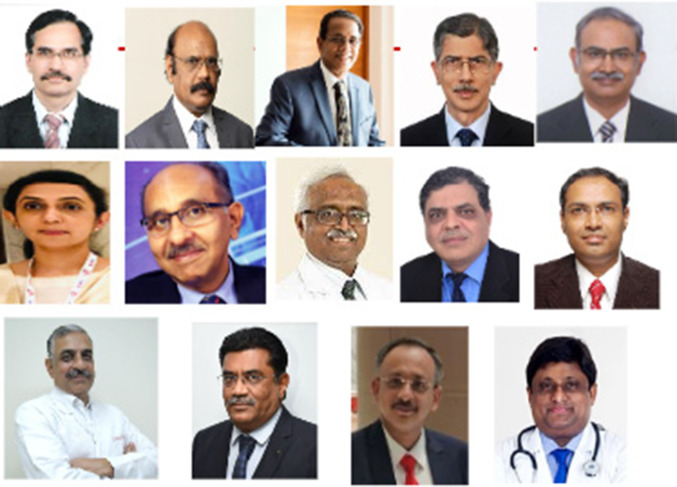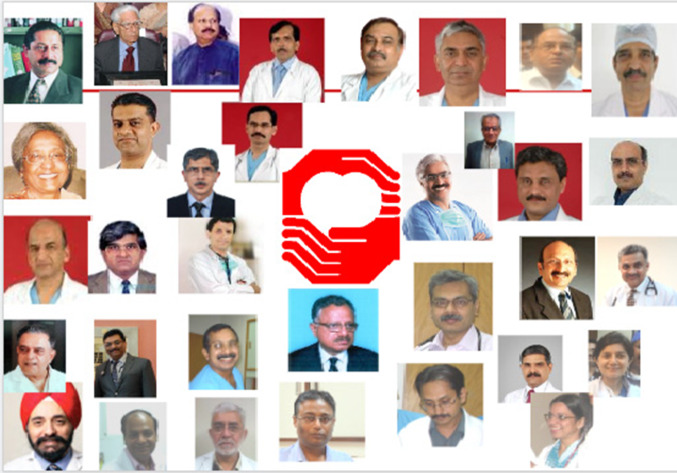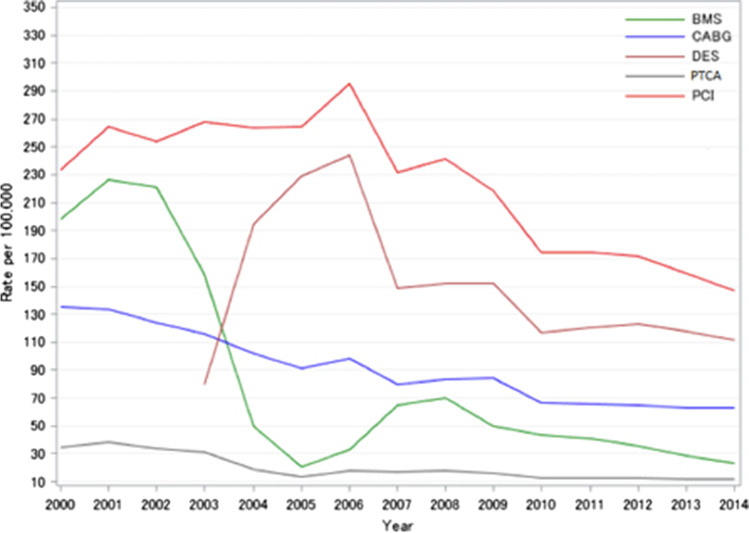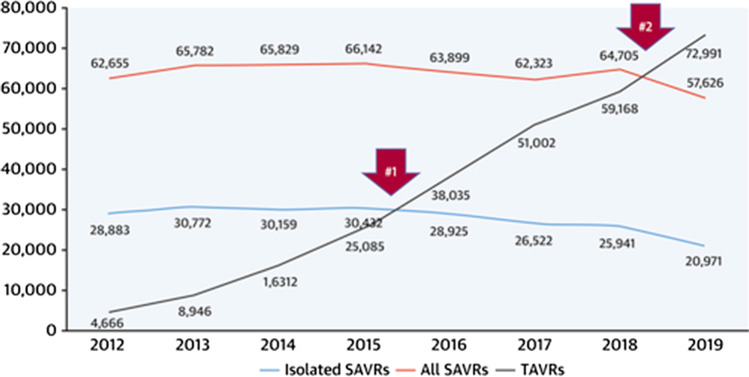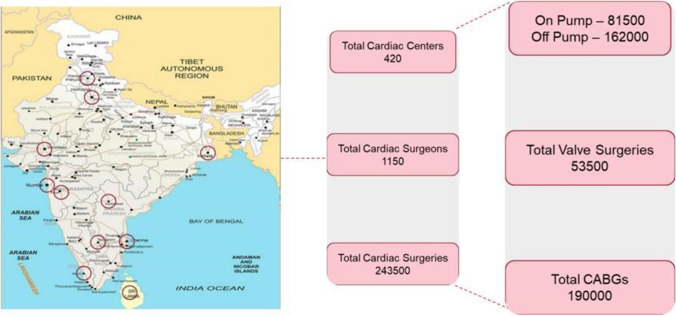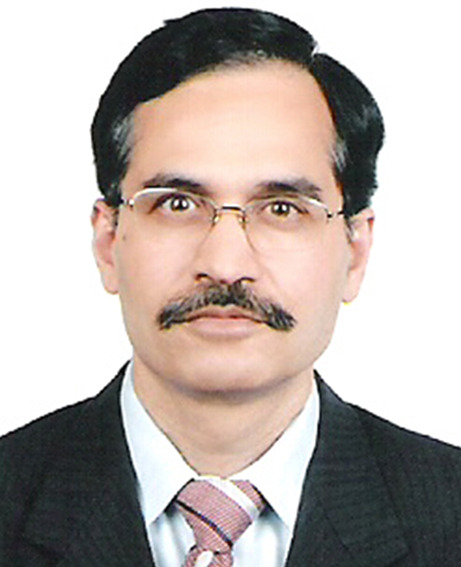
Dear seniors, colleagues, invited guests from overseas, and my dear students, it’s an honour and privilege for me to stand here and address you as the President of our prestigious Indian Association of Cardiovascular-Thoracic Surgeons (IACTS). I am really humbled by this honour and thank you all for giving me this opportunity. Before I start, I want to thank God for blessing me more than I deserve and giving me the strength to accomplish my goals and overcome all the challenges of life. I am proud and privileged to be associated with the association for 4 decades. I attended the first meeting of the association in Srinagar in 1986 when it was held with Cardiological Society of India. Our association has progressed over the last many decades from a small group to a large association with 2454 members as on 17.3.2023. IACTS is a well-recognized and respected body now.
Over the last 3 years as executive member in different capacities and over the last 1 year as President, I had the privilege of working with a very dedicated team of executive members (Fig. 1) and I want to thank them all. I want to thank Dr V. V. Bashi, who steered the association during the challenging times of the coronavirus disease 2019 (COVID-19) pandemic. He kept the morale of the members high and ensured that our academic activities continue for the benefit of our students and all members. My special thanks to Dr K. S. Iyer, who has not only contributed immensely to take the association forward but has been a great colleague and friend for almost 3 decades. I want to take this opportunity to welcome the incoming president, Dr Lokeshwar Rao Sajja, who is not only a great clinician but also a great researcher. I am confident that he will take the association to further heights. Dr C. S. Hiremath, our young dynamic secretary, has been a very energetic, proactive, and dedicated member of the association. I want to thank him for his commitment and dedication. Dr O. P. Yadava, Editor-in-Chief of the Indian Journal of Thoracic and Cardiovascular Surgery, has taken the journal to great heights. He has been immensely contributing during the Executive committee meetings with his very valuable comments and advice. I want to express my sincere thanks to him. I want to thank Dr Prabhatha Rashmi, who took over as joint secretary and treasurer last year. She is working hard to streamline the accounts and auditing processes of the association. I also want to thank all other executive committee members: Dr B. R. Jagannath, Dr Shamsher Lohchab, Dr Manoj Durairaj, Dr Alok Mathur, Dr Gaurav Goyal, and Dr Siva Muthukumar for their support and contribution.
Fig. 1.
Executive committee, 2022–2023
Friends, all of us have been nurtured and supported by individuals who have truly made a difference in our lives. I want to thank my parents, who in addition to providing love and emotional support, made it possible for me to complete my medical education in spite of all the odds and financial challenges. Most importantly, I want to thank my wife Alka and my daughter Mohini, who have been source of inspiration for me. My wife has been an enabler in the finest sense of the word. Her support, her sacrifices, her eternal optimism, and her cheerful assumption of many family responsibilities have made it possible for me to pursue my professional interests to the fullest. I am proud of my daughter Mohini. She has inspired me every day to grow and be better. She loves interacting and collaborating with people and so she decided to be Human Resources (HR) professional. She did her Masters from her dream University, London School of Economics, and decided to continue working in the United Kingdom.
For us as doctors, teachers are the most important persons to play a pivotal role in moulding us. I want to thank all my teachers during my graduate and post graduate education and training for shaping me not only as a good doctor but also as a good human being. I also want to thank my mentors for their advice, guidance, assistance, and hand holding during my Cardiothoracic Surgery training.
I have been associated with several outstanding colleagues over the last 4 decades of my career in Cardiovascular Surgery and they are too many to mention individually. I want to thank all of them for their support. I thank all my colleagues who have been part of my journey in Cardiac Surgery at Fortis Escorts Heart Institute (Fig. 2), where I have been practicing for more than 3 decades and still continue to practice there. My special thanks to Dr Naresh Trehan, who nurtured the team at Fortis Escorts Heart Institute which became one of the premier and most respected cardiac centres in the country. Members of my present team are sincere, hardworking, and dedicated to patient care (Fig. 3). Many of them are working with me for more than 10 years and some of them are actually working for more than 20 years. I also want to take this opportunity to thank my residents, perfusionists, nurses, technicians, and support staff who have been part of my journey over many decades.
Fig. 2.
My colleagues at Escorts Heart Institute
Fig. 3.
My current team
Friends without speaking much about myself and my journey, I will like to go directly to my topic today, except saying that like most of you, I joined Cardiovascular Thoracic surgery out of my passion. Over the last many years, we have been reading articles like “Is cardiac surgery dying?” [1], “Is it true that cardiac surgery is a dying field because of advancement in non-surgical technologies” [2], and “The cardiac surgeons, a dying breed” [3] in both medical journals and lay man press. Very recently, The Economist published the article “Bypassed: are heart surgeons dying out?” [4]. In this article, the author has elaborated his interaction with cardiac surgeon and the cardiologist at St Bartholomew’s Hospital in London. We have to accept the fact that a large number of Doctorate of National Board (DrNB) and Magister Chirugiae (MCh) seats are going vacant and we are not able to attract the best talent in Cardiothoracic surgery. There is no doubt that there are challenges in Cardiothoracic surgery. The speciality is very demanding, the training period is quite long, there is late settlement in life, and difficulties in finding suitable job placement, poor reimbursement, and difficult to maintain work-life balance. Therefore, when I was thinking about the theme of my address, I decided to speak on the challenges and opportunities in our speciality. So the title of my talk is going to be:
“Equal to the challenge”
Cardiac surgery in India — as many opportunities as there are challenges
Friends, there was the time when being a cardiac surgeon had a very special status. Everyone wanted to be around us. Everything was glamourous in cardiovascular surgery and everyone used to envy us. Exposing, touching, and operating on the heart was considered very special and prestigious. Performing various cardiac procedures like coronary artery bypass grafting (CABG), valve repair and replacement, and many other procedures elevated us to a different level in the medical field. We considered ourselves unbeatable. But in 1977, Dr Andreas Grüntzig, a German cardiologist, practicing in Zürich, changed the cardiovascular world forever. None could foresee his impact, and none thought back then that more than 40 years later we would be fighting to survive in a catheter-based panorama. We all saw the impact of percutaneous coronary interventions (PCI) on the volumes of CABG across the world. In the USA, the number of CABG procedures dropped to almost half between 2000 and 2014 [5] (Fig. 4). As if that was not enough, it happened again in 2002, when Alain Cribier, a French cardiologist, implanted an aortic valve completely percutaneously. This was another wakeup call for us and we have seen the impact of this. The number of transcatheter aortic valve implantation (TAVI) procedures exceeded all forms of surgical aortic valve replacement (SAVR) in the USA in 2019 [6] (Fig. 5).
Fig. 4.
Age-adjusted PCI, CABG, DES, BMS, and PTCA hospitalization rates per 100,000 in the United States from 2000 to 2014
Fig. 5.
STS/ACC TAVI registry
So are we facing the dusk of the field or are there still many opportunities in cardiac surgery? Friends, I am not ready to accept that ours is a dying speciality and cardiac surgeons have no future. In fact, I am convinced that there are many opportunities in our speciality, even though there are challenges. We all have to work together and explore these opportunities. Let me start by this research report, which was published recently by Morgan Stanley, “India’s Impending Economic Boom” [7]. According to this research report, India is on track to become the world’s third largest economy by 2027, surpassing Japan and Germany, and has the third largest stock market by 2030. Can healthcare in general and cardiac surgery in particular use this momentum? My answer is Yes. In fact, the healthcare market in India has steadily grown from 2008 to 2022. In 2022, the size of the healthcare market in India was 372 US billion dollars [8].
One of the challenges has been that India’s healthcare system has been majorly concentrated in the larger cities but that is changing now. Tier 2 and tier 3 cities are experiencing the healthcare revolution. In fact, according to a report [9] “From the return on investment (ROI) perspective, Tier 2 and Tier 3 cities are lucrative markets. Lesser competition, low penetration of healthcare and people’s affinity with the internet are factors that hold potential for the healthcare start-ups”. There is changing scenario of healthcare in tier 2 and tier 3 cities. There has been an increased investment diversification for the overall development of healthcare infrastructure in tier 2 and tier 3 cities. This is also exemplified by the fact that there are now 19 All India Institute of Medical Sciences (AIIMS) in India that are operational as of January 2022, many of them in tier 2 cities. By the end of 2025, five additional AIIMS are anticipated to open in India. Government initiatives like Ayushman Bharat, Ayush Mission, and Pradhan Mantri Swathya Suraksha Yojna are proving to be game changers for the smaller towns and rural areas.
As far as the Cardiac Surgery is concerned, there is still a huge gap between the demand and supply of the number of surgical procedures performed. According to industry data (Fig. 6), there are about 420 cardiac centres in the country performing Cardiac Surgery. The number of cardiac procedures performed are estimated to be around 300,000 per year. The demand is much higher. On the other hand, there are about 2200 cardiac catheterisation laboratories (cath lab) in the country with many cath labs added every year. This gives us an opportunity to affiliate to these cath labs which will be the feeding centres for cardiac surgery.
Fig. 6.
Adult cardiac surgery volume in India
Every industry performs what is known as Strengths, Weaknesses, Opportunities, and Threats (SWOT) analysis. This is basically the analysis of strengths, weaknesses, opportunities, and threats. We also have to analyse our strengths, weaknesses, opportunities, and threats. We are already strong in many areas. We have to explore opportunities. Off-pump coronary artery bypass (OPCAB) grafting is one of the areas where we are leaders. Let me talk a bit about OPCAB in our country. Off-pump CABG started in the mid-1990s. We picked up this technique faster than in other parts of the world. While in North America it peaked to 25% and there has been a steady decline after that, off-pump CABG is increasing in India. Currently, off-pump CABG is performed in more than 60% of patients undergoing isolated CABG in our country. The benefits and risks of OPCAB have been the subject of several large randomized control trials, observational studies, registries, and > 60 meta-analyses. There have been concerns in OPCAB related to technical complexity, completeness of revascularization, and graft patency. Many randomized control trials and meta-analyses have compared long-term clinical outcomes after on-pump and off-pump coronary artery bypass. I will not go into details of these studies but I will like to briefly mention two studies — Coronary Artery Bypass Surgery (CABG) Off or On Pump Revascularization Study (CORONARY) and Arterial Revascularization Therapies (ART) trial. The CORONARY trial [10] was a multi-national, multi-institutional, randomized control trial across 19 countries involving more than 4700 patients. Many institutions from India including our institute participated in this trial. One of the important inclusion criteria in this trial was surgeon’s expertise which was defined as more than 2 years of experience after residency training and completion of more than 100 cases of the specific technique (either on-pump or off-pump CABG). Trainees were not allowed to be the primary surgeon. Five-year outcomes after off-pump or on-pump were published in 2016. At 5 years, there were no significant differences between the on-pump and off-pump group in the rate of the composite outcome (death, stroke, myocardial infarction, renal failure, or repeat coronary revascularization) or in the rates of components of the outcomes, including repeat coronary revascularization.
The other study which I will like to mention is the ART trial [11]. Ten-year outcomes after off-pump versus on-pump CABG were recently published. ART was not a comparative trial between off-pump and on-pump CABG. This was actually a study to compare the outcomes between single and double internal mammary artery. The authors performed post hoc analysis of ART trial to compare 10-year outcomes after on-pump and off-pump CABG. At 10 years, when compared with on-pump, there was no significant difference in death or the composite of death, myocardial infarction, stroke, and repeat revascularisation in off-pump CABG. However, off-pump surgery performed by low-volume off-pump surgeons was associated with a significantly lower number of grafts, increased conversion rates, and increased cardiovascular death (hazard ratio, 2.39; 95% confidence interval, 1.28–4.47; P = 0.006) when compared with on-pump surgery performed by on-pump-only surgeons.
Now, I will like to briefly mention our experience of off-pump CABG at Fortis Escorts Heart Institute. We started OPCAB in the mid-1990s. We presented our first experience of OPCAB in the 5th Annual Meeting of International Society of Minimally Invasive Cardiac Surgery in 2002 in New York. We analysed our data of multi-vessel off-pump CABG in about 5000 patients and published this in The Heart Surgery Forum in 2003 [12]. In 1997, we were doing about 18% of patients off-pump which increased to 50% in 2000 and 92.8% in 2001. We compared post operative results and 30 day mortality. Post operative outcomes were better in off-pump group. In 2005, we published our experience of more than 14,000 patients undergoing off-pump CABG and compared them with on-pump CABG [13]. One of the important concerns in OPCAB is conversion to cardiopulmonary bypass (CPB). Our conversion rate decreased from 5.9 to 1.7% over the years. Currently, our conversion rate is less than 1%. We also analysed our results of off-pump CABG in specific subgroups of patients including elderly patients [14], patients with left ventricular dysfunction [15], patients with left main coronary artery stenosis [16], and patients with multiple high-risk factors [17]. The outcomes were found to be better in the off-pump group. I acknowledge that all these are observational retrospective studies and have limitations. I feel off-pump CABG is an opportunity for us in India. It is associated with better early postoperative outcomes leading to shorter intensive care unit (ICU) and hospital stay, lower cost, and can be practiced in small centres with limited resources.
Before I proceed further, I will like to mention the story of Pandora. I am sure, many of you must have heard about this story. Zeus made Pandora, the first mortal woman, because he was mad at Prometheus who had given the mortals special gifts, so he decided to give them one more: Pandora. Each God gave her something to make her perfect. Venus gave her beauty, Mercury gave her persuasion, Apollo gave her music, Hephaestus gave her voice, Hermes gave her pettiness in her tiny brain, etc. etc. Finally, she was ready for Earth. Zeus gave her to Epimetheus (Prometheus’ brother). Prometheus had said to Epimetheus not to take anything from the Olympians, especially Zeus. Epimetheus was about to decline Pandora but as soon as he looked at her and saw her beauty, he accepted Zeus’ gift. Epimetheus gave Pandora a box that she was forbidden to open. Every day, Pandora wondered what was in the box. She knew she shouldn’t open it, but she was extremely curious and could not bear not to know its contents. As soon as she pulled the cover off, all of the evil and mistrust flew out into the world. When Pandora looked at the bottom of the box, she saw that the only thing left was hope. Friends, we have to look deep and we will find lots of hope and opportunities.
The other areas where I feel there are opportunities in Cardiovascular Surgery include minimally invasive cardiac surgery, aortic surgery, heart and lung transplant, and pediatric and congenital heart surgery. Many centres are already doing extremely well in aortic surgery, minimally invasive surgery, and paediatric and congenital heart surgery. More centres need to start these programs.
I will like to briefly mention about heart and lung transplant in India. Many of you, those who have interest in heart and lung transplant and those who have worked in the UK, must have heard about Harefield Hospital. While I was working in King’s College Hospital, London, out of interest, I decided to spend few weeks at Harefield Hospital to look at their cardiac surgical programs, specifically their transplant program. I used to go there whenever there was a heart transplant. Though, at the back of my mind, I always used to think whether this will ever become a reality in India. Interestingly, the same year, while I was visiting the Harefield Hospital, the news about India’s first successful heart transplant came on 3 August 1994. I was really happy and excited to read this news. This was an important landmark in cardiac surgery in India. For the next two decades, there was not much activity in the field of transplant, but over the last few years, there has been significant increase in the transplant activity across the country. The number of transplant centres has increased as well as the number of procedures. In fact, the number of transplants almost doubled from 2015 to 2018, though the absolute number of transplants is still very low as compared to that in the USA and Europe. I strongly feel that there will be significant growth in this field and there is huge opportunity, because the number of patients in advanced heart failure requiring transplant is huge. We definitely have challenges in transplant including challenges in infrastructure, trained manpower, donor availability, poor referral by physicians, and cost. But things are improving fast.
We are one of the world’s leading nations in the volume and quality of many cardiac procedures, but we need to analyse, present, and publish our data. The first step in this direction is having our own national database. IACTS is working hard over the last 2 years under the chairmanship of Dr K. S. Iyer to establish national database. I want to thank and congratulate the IACTS database committee for their efforts. I also want to thank Venkat who is helping us in this mission and also Raghuram, our database manager. We currently have 12 institutions entering data in the database with data of 14,769 patients entered until February 2023. I appeal to all the surgeons to register their Institutes and be part of the database so that at the end of few years, we can have representative national data. We also need to publish good-quality articles, both in our Indian and international journals. We also need to conduct multi-institutional randomized control trials.
We have a great opportunity in medical tourism. India is the preferred destination for medical tourism. India’s medical tourism is amongst the fastest growing subsectors in the industry. According to many research reports including the report by KPMG [18] “with its key differentiating factors of extremely competitive pricing, highly trained doctors, high quality care and availability of a range of treatments, India has realized the potential of medical tourism and positioned itself as one of the largest service providers in this region”. According to a research report published in Dublin very recently [19], the India Medical Tourism Market is expected to generate US$ 35.12 billion in 2027 from US$ 5.63 billion in 2021. It is because of world-class doctors and hospitals, where cost of the treatment is a fraction of the price in the source markets; there is no waiting period for various medical procedures with increasing popularity of India as a medical tourist destination in the African, Middle East, and Asian countries. It says that India has Eastern Healthcare Wisdom along with the expertise of Western medicine. According to a report [20] (Fig. 7) which analysed the cost of coronary artery bypass in selected countries in 2019, the United States was at the top with US$ 123,000 as the cost of CABG. India was at the lowest with US$ 7900. In fact, we were lower in comparison to our competitors including Singapore, Thailand, Turkey, and Malaysia.
Fig. 7.
Size of the healthcare market in India from 2008 to 2022 (in billion US dollars)
Friends, we will have to change the way we have been practicing for years. We will have to provide leadership and be the watchdogs as the cardiovascular therapeutic space moves forward. We need to connect directly with the public. With this aim, IACTS recently launched Outreach Program on World Heart Day, 29 September 2022. The vision of this program is to reach out to the public through social media and outreach events, engage with the public to foster cardiac health, disseminate knowledge regarding heart diseases and the best treatment available that is based on scientific evidence, and to ensure the best standard of care to our patients.
To achieve our goals of taking our speciality forward and attract the best talent in cardiovascular surgery, we need to have a relook at our training. The contemporary Cardiac Surgeon today needs to have the triad of required expertise to master the full spectrum of therapeutic options in Cardiovascular Surgery. These include not only surgical expertise but also the catheter expertise as well as imaging expertise. As we all know, catheter-based interventions are increasing for various cardiovascular diseases, which is clearly exemplified by fast growth of TAVI over the last few years. More and more structural heart diseases are being managed now by catheter-based procedures, which will continue to increase. Our training therefore needs to incorporate catheter-based skills which should be integral part of curriculum of MCh and DrNB. IACTS executive members recently had a meeting with the Executive Director of National Board of Examinations and handed over to him the suggestions regarding the modifications in curriculum of DrNB. In the same direction, IACTS is working on establishing Centre of Excellence, which will be used for wet lab trainings, simulation trainings, regular continuing medical education (CME), as well as other academic activities. I hope this becomes a reality soon. IACTS has already started many fellowship programs. We need to have these fellowships in other areas like structural heart disease, heart transplant and mechanical circulatory support, minimally invasive cardiac surgery, and aortic surgery.
Friends, whenever there is a challenge, there is also an opportunity to face it, to demonstrate and develop our will and determination (Dalai Lama).
Every President of the United States, when he leaves office, leaves on his desk a confidential letter to his successor of unfinished business and outlining the important issues facing the nation. If I have to outline the most important issue facing our speciality and our association to my successor Dr Lokeshwar Sajja and all of you, I would say “Let’s work together to create positivity in our next generation, focus on teaching and training and mentorship and work towards attracting talent to our speciality, convert our challenges into opportunities and continue to serve the society”. We are Cardiovascular surgeons and confidence flows in our blood and I believe, we all are born with the ability to change. Let’s convert our challenges into opportunities.
I once again thank you for the honor of serving as your 53rd President.
Funding
None.
Declarations
Conflict of interest
No conflict of interest.
Footnotes
Presidential address delivered at the 69th Annual Meeting of the Indian Association of Cardiovascular Thoracic Surgeons, India, Coimbatore, February 2023.
Publisher's note
Springer Nature remains neutral with regard to jurisdictional claims in published maps and institutional affiliations.
References
- 1.Guerra M. Is cardiac surgery dying?. Rev Port Cir Cardiotorac Vasc [Internet]. 2023 Jan. https://pjctvs.com/index.php/journal/article/view/309
- 2.Is it true that cardiac surgery is a dying field because of advancements in non-surgical technologies? Priya, January 14, 2023. https://indiaplus.in/is-it-true-that-cardiac-surgery-is-a-dying-field-because-of-advancements-in-non-surgical-technologies/
- 3.Saissan Rajendran. The cardiac surgeons, a dying breed. May, 2012. Australian Medical Student Journal (amsj.org). C:\Users\Admin\Downloads\https:\www.amsj.org./archives/1989 The cardiac surgeon, a dying breed? | Australian Medical Student Journal (amsj.org) https://www.amsj.org/archives/1989
- 4.Bypassed: are heart surgeons dying out? By Simon Akam. The Economist. https://www.economist.com/1843/2023/01/29/bypassed-are-heart-surgeons-dying-out.
- 5.Hao H, Pattisapu V, Cen Y, Shavelle D. Coronary revascularization trends in the United States, 2000–2014. Circulation. 2019;140:A10874. [Google Scholar]
- 6.Data from the STS/ACC TVT Registry provides insights on ‘State of TAVR in the United States’ American College of Cardiology, November, 2020.
- 7.“India’s impending economic boom”, Stanley Morgan. https://www.morganstanley.com/ideas/investment-opportunities-in-india.
- 8.Indian healthcare market to hit $372 billion by 2022. https://economictimes.indiatimes.com/industry/healthcare/biotech/healthcare/indian-healthcare-market-to-hit-372-bn-by-2022/articleshow/61903998.cms?from=mdr
- 9.Tier 2 and 3 cities are experiencing the healthcare revolution. Tier 2 and 3 cities are experiencing the healthcare revolution | The Financial Expr https://www.financialexpress.com/healthcare/news-healthcare/tier-2-and-3-cities-are-experiencing-the-healthcare-revolution/2544025/ess
- 10.Shroyer AL, Hattler B, Wagner TH, Collins JF, Baltz JH, Quin JA, et al. Five-year outcomes after on-pump and off-pump coronary-artery bypass. N Engl J Med. 2017;377:623–632. doi: 10.1056/NEJMoa1614341. [DOI] [PubMed] [Google Scholar]
- 11.Taggart DP, Gaudino MF, Gerry S, Gray A, Lees B, Sajja LR, et al. Ten-year outcomes after off-pump versus on-pump coronary artery bypass grafting: insights from the Arterial Revascularization Trial. J Thorac Cardiovasc Surg. 2021;162:591–599.e8. doi: 10.1016/j.jtcvs.2020.02.035. [DOI] [PubMed] [Google Scholar]
- 12.Meharwal ZS, Mishra YK, Kohli V, Singh S, Bapna RK, Mehta Y, et al. Multivessel off-pump coronary artery bypass: analysis of 4953 cases. Heart Surg Forum. 2003;6:153–159. [PubMed] [Google Scholar]
- 13.Mishra YK, Mishra M, Malhotra R, Meharwal ZS, Kohli V, Trehan N. Evolution of off-pump coronary artery bypass grafting over 15 years: a single-institution experience of 14,030 cases. Innovations. 2005;1:88–91. doi: 10.1097/01.imi.0000189937.33748.19. [DOI] [PubMed] [Google Scholar]
- 14.Meharwal ZS, Trehan N. Off-pump coronary artery surgery in the elderly. Asian Cardiovasc Thorac Ann. 2002;10:206–210. doi: 10.1177/021849230201000303. [DOI] [PubMed] [Google Scholar]
- 15.Meharwal ZS, Trehan N. Off-pump coronary artery bypass grafting in patients with left ventricular dysfunction. Heart Surg Forum. 2002;5:41–45. [PubMed] [Google Scholar]
- 16.Meharwal ZS, Trehan N. Is off- pump coronary artery bypass surgery safe for left main coronary artery stenosis? Indian Heart J. 2001;53:314–318. [PubMed] [Google Scholar]
- 17.Meharwal ZS, Mishra YK, Kohli V, Bapna R, Singh S, Trehan N. Off-pump multivessel coronary artery surgery in high-risk patients. Ann Thorac Surg. 2002;74:S1353–S1357. doi: 10.1016/S0003-4975(02)03915-2. [DOI] [PubMed] [Google Scholar]
- 18.Medical value travel in India. KPMG. KPMG-FICCI Medical value travel with its key differentiating factors of extremely competitive pricing in India
- 19.India Medical Tourism Markets Report 2022: a $35.12 billion market by 2027 - a synergy of unique holistic health and wellness ecosystem. Dublin, Nov. 21, 2022 (GLOBE NEWSWIRE). India Medical Tourism Markets Report 2022: A $35.12 Billion Market by 2027 - A Synergy of Unique Holistic Health and Wellness Ecosystem (yahoo.com)
- 20.Median prices for coronary bypass surgery in hospitals in select countries in 2019. Hospital price coronary bypass surgery select countries 2019 | Statista https://www.statista.com/statistics/312250/hospital-and-physician-cost-of-a-bypass-surgery-by-country/



